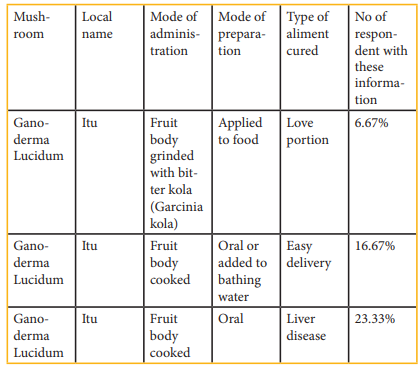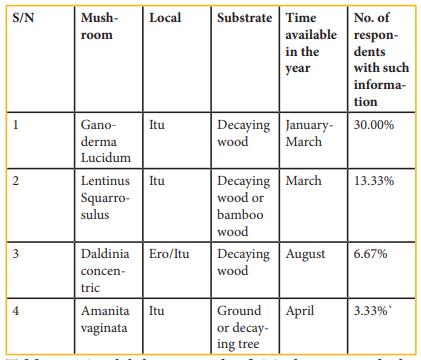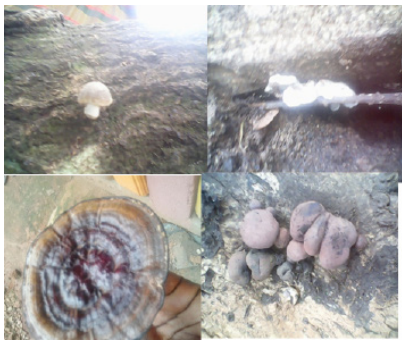Author(s): Okigbo RN and Obanubi SI
A study on the medicinal mushroom (Ganoderma lucidum) was conducted from May to July 2015 to document the medicinal importance of Ganoderma lucidum “Itu” by the Warri South people in Warri, Delta State, Nigeria. This mushroom was identified and collected during field trip and visits to traditional medical practitioners. Four mushrooms species were identified out of which 2 are edible, 1 is used medicinally and 1 is feared by the locals and trial’s of the community because of its poisonous content. These mushroom were briefly described, their uses, local names and part used were listed. These mushrooms are faced with rapid extinction because its knowledge and use are not passed to younger generation.
Mushrooms can be defined as macro fungi having distinctive fruiting bodies which grow either on the ground or substrates which can be seen with the naked eye and picked by hand Chang [1]. Ganoderma lucidum, a large, dark mushroom with a glossy exterior and woody texture is an oriental fungus. In the Southern part of Nigeria, G. lucidum is called Itu (representing a combination of spiritual potency and essence of life) and in the eastern part of Nigeria, it’s called Ero (Cooner). The family Ganodermataceae describes polypore basidiomycetous fungi having double walled basidiospores (Donk). In all, 219 species within the family have been assigned to the genus Ganoderma (Moncalvo). Warri South is a Local government in Warri, Delta-State. The area is predominantly riverine, due to its soil type and vegetation type, this area is ideal for hosting and flourishing mushrooms. Medicinal mushrooms have long and rich history of use. More than 2,000 years ago, Paleolithic people knew and used mushrooms as powerful medicines to fight illness [2]. The medicinal use of mushrooms has a very long tradition in Asian countries, whereas their use in Western hemisphere has been slightly increasing only since last decades [3]. Lucidum‘Itu’ has been recognized as a medicinal mushroom for over 2,000 years and its powerful effects have been documented in ancient scripts [3]. Mushroomssplendid taste, but also for their health benefits [4]. In addition to its nutritive value, mushroom possess some essential mineral nutrients which are considered as key factors for the normal functioning of the body [5]. And also used as an immune stimulant [6]. The specific applications and attributed health benefits of G. lucidum, ‘Itu’ include control of blood glucose levels, modulation of the immune system [7]. The various beliefs regarding the health benefits of G. lucidum are based largely on traditional cultural uses. However, recent reports provide scientific support to some of the ancient claims of the health benefit of G. lucidum‘Itu’ [8]. Lucidum‘Itu’ have long been used as a valuable food source and as traditional medicines around the world especially in Japan and China and in the Southern part of Nigeria (Hirano). Lucidum has been used for hundreds of years as a health promotion and treatment strategy in viral bacterial infection, diabetes, and liver injury [9]. Lucidum has been used for several thousand years in traditional medicine of the Far East for the treatment of various diseases including immunological disorders, asthma, and hepatitis. Ganoderma specie are natural sources of various antimicrobial, antioxidant, active compounds (Budavari). The low total fat content and high proportion of polyunsaturated fatty acids relative to the total fatty acids of mushroom are considered significant contributors to the health value of mushrooms [10,11]. Polysaccharides, peptidoglycans, tritepenes are three major constituents in Ganoderma lucidum [12,14].
The components of medicinal mushroom have long been ignored by many biomedical practitioners because its chemical composition, dosage and toxicity are not clearly defined [15]. Also, most traditional medicine practitioners tend to hide the identity of these mushrooms e.g. [G. lucidum]. Used for different ailments owing to the fact that they might lack patronage. Elemental analysis of 10g cultivated fruit bodies of G. lucidum revealed silica, sulphur, potassium, calcium and magnesium to be their main mineral components. Iron, sodium, zinc, copper, manganese and strontium were also detected in lower amounts [16]. Lucidum collected from the wild can also contain selenium (Se - up to 72μg/g dry weight). And Germanium (489μg/g). Germanium at lower doses has been credited with immunopotentiating, antitoxidant activities. Furthermore, G. lucidum spores were reported to contain a mixture of several long chain fatty acids that may contribute to the antitumor of the mushroom (Fukuzawa). Numerous G. lucidum products, prepared from different parts of the mushroom, are currently available on the market [17]. This study is aimed at documenting the medicinal potentials of Ganoderma lucidum in Warri South LGA, Warri Delta- State, Nigeria for eradicating some ailments and then create awareness to a large number of people.
The materials used include: Writing materials, sterile polyethylene bags, Razor blade, Species of mushroom obtained from farmland in Warri South Local Government Area, Questionnaire. The method of Chang, et al. was used in the study area which involved the use of a well-structured questionnaire to obtain vital information from the respondents [18,19].
The study region includes 3 communities in Warri South Local Government (Ubeji, Ekurede and Ajamimogha) which lies in between 50 31’N50 45’E latitude and 5.517oN5.750oE longitude, covering an area of 633km2. Here, the soil is rich in nutrients with sandy loam to clay loam characteristics and PH range of 5.4-6.6. The area comprises of 3 ecological regions - Mangrove vegetation, freshwater swamp and lowland rainforest. The vegetation is dominated by mangrove trees, shrubs and grasses.
A three months (May - June) survey among the three communities revealed that quite a number of macro fungal species grow on dead tree trunk and on ground which are consumed by the locals / tribal communities and to cure various ailments. The specimen (Ganoderma lucidum) was collected and put in the sterile polyethylene bag. . Those attached to a tree were carefully cut using razor blade (not allowing its sporophores to scatter), and the ones on dead wood (not strongly attached to the substrate) were carefully and gently pulled out. It was photographed in the sampling site and preservedusing a standard preservation technique.
During the survey, respondents (ages 25 - 75years) gave the local name, uses, beliefs and mode of preparation of the mushroom. The collected information regarding G. lucidum utilizations among the communities were verified by cross questioning key informants such as village elders, herbalist. Local market of each community was visited to find out its use in local communities and variation demands among clientele.
The mean treatment of the analysis was obtained using Randomized Complete Block Design (RCBD) and simple percentage.
The study showed that people in these communities collect and consume different types of mushroom as food and for treatment of several ailments (Plate 1). Altogether, 4 macro fungal species were found to be used by the locals and tribals of the regions among which 2 mushroom species were found to be edible (Lentinus squarrosulus and Amanita vaginata), 1 species used for medicinal purposes (Garnoderma lucidum) and 1 species found to be dangerous (Daldinia concentrica) (Table 1.0).
Of these species, Ganoderma lucidum was consumed more because of its medicinal uses like; its use in the cure of liver disease, for ease / safe delivery in pregnant women, and as love portion. It use as love portion is mainly by traditional men and women as younger generation has little or no knowledge about it. Its various uses can be administered orally, by adding the mushroom (G. lucidum) to bathing water or added in a food. The fruit body plays an important role and can be cooked, chewed or grinded with other fruit substances such as Garcinia kola (Table 3.0). G. lucidum was preferred to other species of mushroom because of its nutrient content and medicinal properties; and priced high because of its proteineous content (30.00%) (Table 1.0). Other species, A. vaginata and L. squarrosulus are eaten at minimal quantity, because of its high starchy content (carbohydrate, 30.00%) (Table 2.0). The mushroom species are harvested (in a cool weather) from different substrate such as decaying wood, moist soil, ground and bamboo wood, depending on its availability period in a year (Table, 4.0). Based on tradition, the mushroom collectors never harvested more than the amount needed either for consumption or for medicinal purposes and part of the sporocarp are left at the collection site because they believe that residual part would help the mushroom grow in subsequent favorable conditions. The mushroom G. lucidum was preserved using different media. These include oven drying, sun drying and cooling method (refrigeration). Of these methods, sun drying is commonly used among mushroom farmers because it’s affordable, effective and prevents the mushroom from easy decay. (Table 5.0).
| Reasons | Reasons |
| Carbohydrate | 26.67% |
| Protein | 30.00% |
| Sugar | 10.00% |
| Vitamin | 16.67% |
| Amino acid | 20.00% |
| Fibre | 13.33% |
| Iron | 23.33% |
Table 1: Reason given by respondent for consuming G. lucidum.
| Reasons | Reasons |
| Protein | 26.67% |
| Carbohydrate | 30.00% |
| Vitamins | 20.00% |
| Sugar | 23.33% |
Table 2: Reason given by respondents for consuming A. vaginata and L. squarrosulus.

Table 3: Medicinal uses of G. lucidum by Warri South people.

Table 4: Availability period of Mushroom and the substrate where it is found.
| Methods | Response |
| Sun drying | 50.00% |
| Oven drying | 10.00% |
| Cool method (refrigeration) | 40.00% |
Table 5: Methods used by respondents for preserving G. lucidum and other mushrooms mentioned.
This study showed that mushrooms (Ganoderma lucidum) are still used by the Warri South people mainly the elderly men and women. The use and knowledge of this mushroom (G. lucidum) is rarely passed on to the younger generation because of lack of interest and advancement of technology. The mushrooms seen were examined and grouped into edible and medicinal mushrooms. All mushrooms examined were observed to inhabit mainly on logs of wood, tree trunk and on plain soil.
Mushrooms are however economically important to man within these 3 localities, their values include; source of protein, some essential amino acids, minerals, vitamins and other nutrients which is in line with the reports of Alofe, (1991); Tolentino, (1981) and Mori, (2000). They also have medicinal properties. The challenge then is to promote mushroom use through research and enlightment of the populace. This will help in alleviating some of the two major problems in Nigeria which are food insecurity and unemployment, consequently reducing poverty. Conclusively, like all the people of the world, the Warri South people have their rich traditional or folk medicinal mushroom (G. lucidum) that needs to be properly organized and formerly integrated into the regular health care delivery system.

Figure 1: Medicinal mushroom found in Warri South Local Government Area. a. Amanita vaginata ‘Itu’ b. lentinus squarrosulus ‘Ero/Itu’ c. Ganoderma lucidum ‘Itu’ d. Daldinia concentric.
